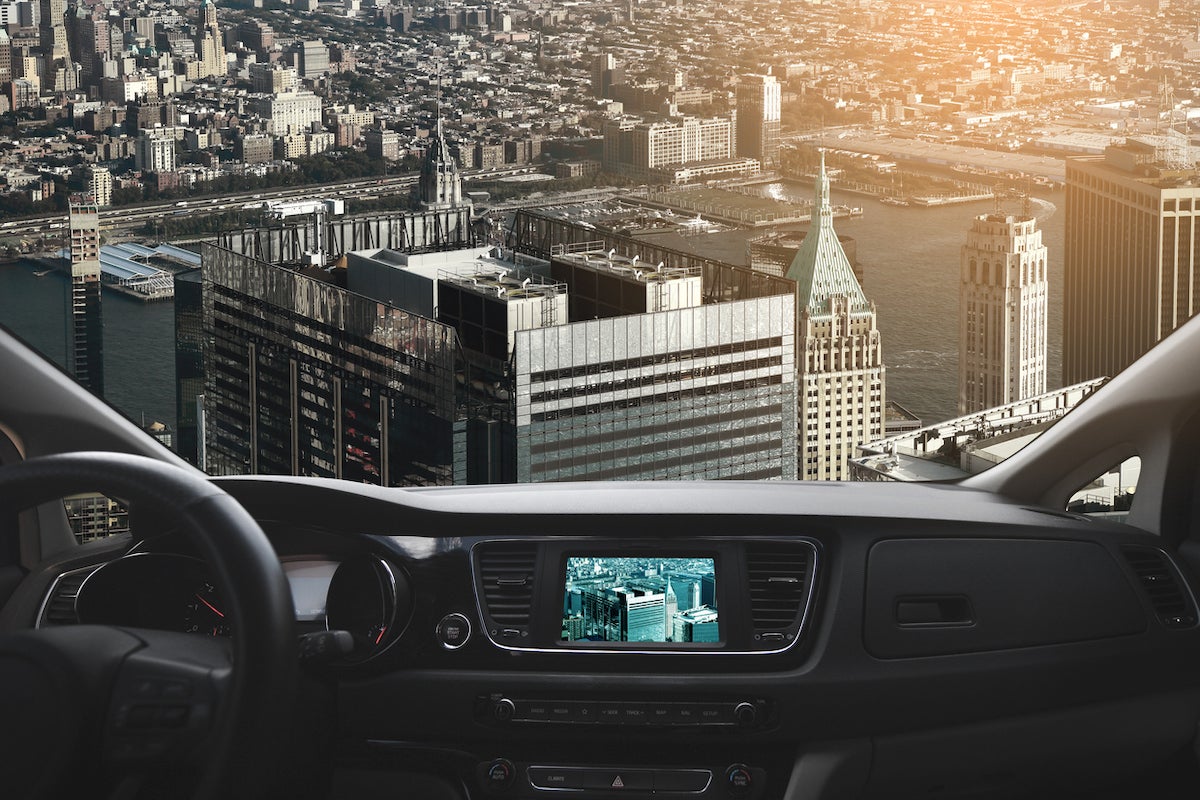Flying taxis taking to highways in the skies were the norm for characters in futuristic cartoons like The Jetsons, but they could become our reality in the near future.
Advanced air mobility (AAM) refers to a collection of innovative airborne technologies that would make the local, on-demand movement of people and goods using autonomous or uncrewed electric aircraft a reality. They are often referred to as electric vertical take-off and landing (eVTOL) vehicles.

For Tim Ravich, associate professor in the College of Community Innovation and Education’s Department of Legal Studies, it’s a concept-turning-reality that could alter the way we view transportation as it exists today.
An aviation lawyer, Ravich’s research interests focus on the regulatory environment related to emerging transportation and communications technologies — including AAM. He recently served as principal investigator of a U.S. National Science Foundation grant that funded the Advanced Air Mobility Conference at UCF in March, teaming up with co-principal investigators and CCIE faculty Sarah Bush and Laurie O. Campbell to facilitate generation of knowledge and identify areas of inquiry regarding the importance and feasibility of AAM.
“AAM is essentially the next natural step in transportation in many parts of the world,” Ravich says.
In recognition of National Aviation Week, Ravich examines the implications of AAM and how it might be introduced in the coming years.
How did you get into aviation law? What excites you about it — and about AAM?
What excites me about aviation, in short, is everything. It’s also exciting to be at the starting line of a new form of technology like AAM. There are all sorts of cheesy cliches that we are today where the Wright brothers were in 1903, for example, but I think there’s some merit to that. This is something that’s quite new, and what’s not exciting about being involved with something new? I have no recall of not being fascinated by all things aviation and, through my career as an aviation lawyer and law professor, it’s just deeply fulfilling on a personal and professional level to be engaged in this space.
Why is the concept — and development — of AAM important?
From a resource or environmental point of view, the concept of a transportation system that could be more efficient in getting people to and from places is essentially why this is important. AAM dates back, at least in the short term, to an “Uber Elevate White Paper,” which imagined ways to reduce traffic congestion through short-haul routes via on-demand urban air transportation. By short haul, we’re talking either intra-city routes — like within Orlando — or intercity routes, say from Orlando to Lake Nona. That’s not really an area that traditional aviation serves. Right now, those are routes that are heavily reliant on cars and trucks. The thought is that this next generation of aircraft fundamentally would operate on battery power and electrified engines. That’s important because it is — at least in theory — an environmentally friendly and economical way of transportation that is otherwise not available currently.
How might AAM integrate into our existing transportation systems?
A big part of this is the regulatory component. The airspace has traditionally been dominated by crewed aircraft. Now, regulators — in collaboration with private and public stakeholders inside and outside of the aviation industry — are working to understand and configure an airspace ecosystem in which the “flying taxis” might operate.
Florida is one of the test beds for several air mobility companies.
Planes — especially commercial aircraft — fly on prescribed routes. These AAM aircraft would probably fly not much higher than about 400 or 500 feet, so they’re not really going to conflict with a commercial aircraft. But they might be flying around airports, or near buildings or ground infrastructure, so there are a number of working groups that are endeavoring to understand where the new “highway in the sky” could be to accommodate them. What we’re seeing from regulators and engineers is we may end up with corridors in the sky, where there are specific areas in which these aircraft — and only these aircraft — can fly.
Everyone is trying to determine where the safest places for these aircraft to fly are, and having dedicated space for that is going to be important. Some companies really do envision a rooftop-to-rooftop scenario. Also, Florida is one of the test beds for several air mobility companies, from Eve Air Mobility — which has a presence in South Florida — to German-based company Lilium, which wants to operate in Lake Nona and offer what is referred to as regional air mobility.
What are the challenges of AAM in urban areas?
First and foremost, make no mistake that the goal here is to have a fully autonomous, uncrewed vehicle. That means no human pilot on board.
Even short of that long-term goal, there are significant concerns attached to AAM. For example, because a lot of this technology is going to be autonomous or internet-based, is it possible that these aircraft could get hacked? Can they be commandeered and used in ways that will threaten local, state and national security, not to mention personal property rights? We do have to manage all the various concerns that people might have. Another issue is unwanted noise, even though the aircraft are surprisingly quiet. You often hear the phrase “not in my backyard,” and some people just wouldn’t want these flying, hovering, loitering, etc. around or near them.
Another focus is on the equity dimension of AAM. It goes beyond economic status and into accessibility.
Another focus is on the equity dimension of AAM. It goes beyond economic status and into accessibility. In other words, are people who have special mobility needs going to be able to use this transportation system easily? Manufacturers in the space are really trying to think broadly about what it means to be inclusive with respect to this technology, not just the laws that are inclusive. They have to consider how to make this technology useful for the broadest demographics and various needs.
There is also a tension between whether we should draft laws that are local or federalized in nature. The airspace in which airplanes fly is called the National Airspace System, and the federal government controls that. The Federal Aviation Administration will want to make sure that there is safety regarding any flying objects wherever it’s located. But local concerns are important, too, and it’ll be interesting to see how it plays out with what I’ll call low-level flights. Can your city control that, or is that going to be left to the Federal Aviation Administration and national regulators? The City of Orlando has invited me to be a part of a task force to chart a path forward on such issues, and we will be meeting beginning this fall.
How do you see advanced air mobility evolving over the next five to 10 years?I’ve seen projections that continue to push this out to about 2028 at the earliest. In July, the Federal Aviation Administration launched its “Innovate28” plan, which essentially is using 2028 as an aspirational date for some of the fundamental AAM systems to go online and when we can expect some of these aircraft operating. Regulators are going to be more conservative or cautious than companies or firms in the space who would like to operationalize their business plans as quickly as possible. It is true that in aviation and a lot of transportation spaces, you sometimes see people get very excited with concepts and they either fail or turn out to be significantly less than what was anticipated. But given the investment and sophistication of people in the AAM space, I think a conservative guess is that this technology will find its way into the marketplace in 10 years on. To be clear, I am bullish about the private sector’s ability to do this in the next decade, though my optimism is tempered by the regulatory environment.
My crystal ball suggests that this will be a viable commercial technology around 2035.
My crystal ball suggests that this will be a viable commercial technology around 2035. In any event, anybody who thinks that the technology itself isn’t ready now is wrong, particularly in the space of cargo, and shipment. These planes are being tested, and they are being certified in the regulatory space. The prevailing thought here is that the best way to get people comfortable with the aircraft is to start with cargo and logistics, to show that they’re flying safely — perhaps autonomously — and reliably. If you could show that, people will start to think, ‘All right, maybe I’ll give this a chance.’ That’s exactly how many of the most important technologies that we today take for granted took flight.





